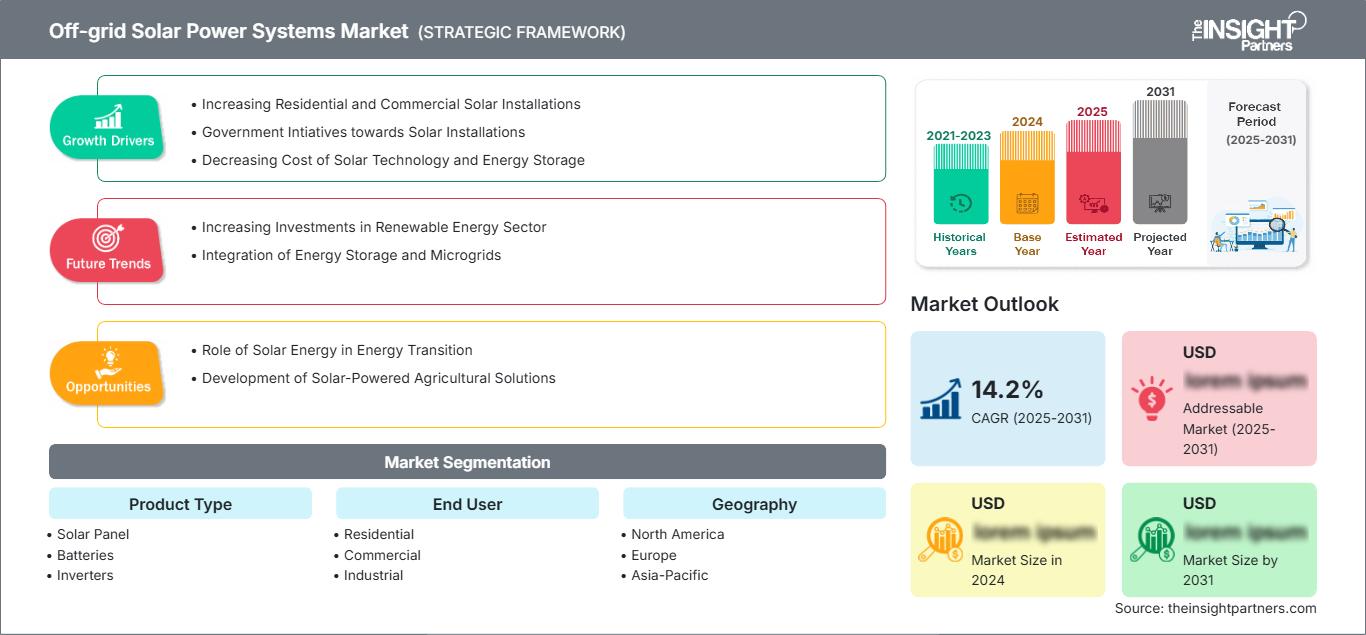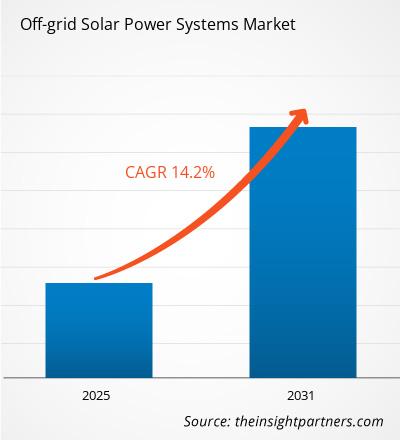Si prevede che il mercato dei sistemi di energia solare off-grid registrerà un CAGR del 14,2% dal 2025 al 2031, con una dimensione del mercato in espansione da XX milioni di dollari nel 2024 a XX milioni di dollari entro il 2031.
Il rapporto è segmentato per tipologia di prodotto (pannelli solari, batterie, inverter e altri). Il rapporto presenta inoltre un'analisi basata sull'utente finale (residenziale, commerciale e industriale). L'analisi globale è ulteriormente suddivisa a livello regionale e per i principali paesi. Il rapporto offre il valore in USD per l'analisi e i segmenti sopra indicati.
Scopo del rapporto
Il rapporto "Off-grid Solar Power Systems Market" di The Insight Partners mira a descrivere il panorama attuale e la crescita futura, i principali fattori trainanti, le sfide e le opportunità. Ciò fornirà approfondimenti a vari stakeholder aziendali, come:
- Fornitori/produttori di tecnologia: per comprendere le dinamiche di mercato in evoluzione e conoscere le potenziali opportunità di crescita, consentendo loro di prendere decisioni strategiche informate.
- Investitori: per condurre un'analisi completa delle tendenze in merito al tasso di crescita del mercato, alle proiezioni finanziarie di mercato e alle opportunità esistenti lungo la catena del valore.
- Organismi di regolamentazione: per regolamentare le politiche e le attività di polizia nel mercato con l'obiettivo di ridurre al minimo gli abusi, preservare la fiducia degli investitori e sostenere l'integrità e la stabilità del mercato.
Segmentazione del mercato dei sistemi di energia solare fuori rete Tipo di prodotto
- Pannello solare
- Batterie
- Inverter
- Altri
Utente finale
- Residenziale
- Commerciale
- Industriale
Potrai personalizzare gratuitamente qualsiasi rapporto, comprese parti di questo rapporto, o analisi a livello di paese, pacchetto dati Excel, oltre a usufruire di grandi offerte e sconti per start-up e università
Mercato dei sistemi di energia solare fuori rete: Approfondimenti strategici

-
Ottieni le principali tendenze chiave del mercato di questo rapporto.Questo campione GRATUITO includerà l'analisi dei dati, che vanno dalle tendenze di mercato alle stime e alle previsioni.
Fattori della crescita del mercato dei sistemi di energia solare off-grid
- Aumento delle installazioni solari residenziali e commerciali: la crescente spinta verso l'energia verde per raggiungere la sostenibilità e la sicurezza energetica è il fattore principale che guida l'implementazione dell'energia solare per soddisfare la crescente domanda e sostituire le fonti di generazione di energia basate sui combustibili fossili. La crescita è principalmente attribuibile alle crescenti iniziative e incentivi governativi, ai progressi tecnologici, alla costante riduzione dei costi e all'elettrificazione rurale, che a loro volta dovrebbero guidare la crescita del mercato dei sistemi di energia solare off-grid nei prossimi anni.
- Iniziative governative per le installazioni solari: il forte sostegno politico governativo continua a essere il principale motore dell'implementazione dell'energia solare in tutto il mondo. Sono state implementate diverse politiche, tra cui aste, tariffe feed-in, net-metering, contratti per differenza, crediti d'imposta sugli investimenti, crediti d'imposta sulla produzione e obiettivi di generazione di energia rinnovabile. Si prevede che tali iniziative guideranno la crescita del mercato dei sistemi di energia solare off-grid nei prossimi anni.
- Riduzione dei costi della tecnologia solare e dell'accumulo di energia: il fattore più significativo che guida la crescita del mercato dei sistemi di energia solare off-grid è il drastico calo dei costi di pannelli solari, batterie e tecnologie correlate. I miglioramenti nell'efficienza dei pannelli solari, il calo dei prezzi delle batterie di accumulo e le innovazioni nella tecnologia delle microreti hanno reso i sistemi solari off-grid più commercialmente praticabili sia per i consumatori che per le aziende. Ciò significa che la riduzione dei costi rende l'energia solare un'alternativa competitiva alle aree off-grid ampiamente utilizzate e ad altre fonti energetiche come i generatori diesel.
Tendenze future del mercato dei sistemi di energia solare off-grid
- Aumento degli investimenti nel settore delle energie rinnovabili: secondo l'Agenzia Internazionale per l'Energia (IEA), la domanda globale di energia è aumentata dell'8% nel 2022. La ripresa degli investimenti nel 2022 è un mix di una risposta ciclica alla ripresa e di uno spostamento strutturale dei flussi di capitale verso tecnologie più pulite. Ad esempio, nel gennaio 2023 il Ministero dell'Arabia Saudita ha annunciato un investimento di 226 miliardi di dollari per lo sviluppo di energia pulita in tutto il Paese. Questo investimento sarà utilizzato per sviluppare infrastrutture eoliche e solari per la produzione di energia in grado di soddisfare la domanda nazionale. Si prevede che tali crescenti investimenti nelle energie rinnovabili, in particolare nel solare, creeranno opportunità nel mercato dei sistemi solari off-grid.
- Integrazione di accumulo di energia e microreti: con la crescente complessità dei sistemi solari off-grid, l'integrazione con sistemi di accumulo di energia come batterie agli ioni di litio e tecnologia delle microreti è una tendenza in crescita. L'accumulo di energia garantisce che l'energia solare prodotta durante il giorno possa essere utilizzata di notte o durante le giornate nuvolose, migliorando l'affidabilità dei sistemi off-grid. Il solare off-grid è reso più affidabile grazie alla flessibilità nella gestione dell'energia offerta dalle microreti, che consentono la generazione e la distribuzione di energia a livello locale. Tali tendenze sono molto importanti per le applicazioni che richiedono un'alimentazione costante 24 ore su 24, 7 giorni su 7, come le strutture sanitarie e le piccole industrie.
Opportunità di mercato per i sistemi di energia solare off-grid
- Ruolo dell'energia solare nella transizione energetica: la transizione energetica consiste nel passaggio dalla dipendenza dai combustibili fossili a fonti energetiche rinnovabili e più pulite. Questo cambiamento risponde all'urgente necessità di soluzioni energetiche sostenibili ed ecocompatibili. Negli ultimi decenni si è assistito a un aumento delle emissioni di anidride carbonica (CO2), contribuendo al cambiamento climatico. La transizione verso fonti energetiche rinnovabili ed ecocompatibili è una strategia fondamentale per ridurre queste emissioni e mitigare i danni ambientali. Si prevede che tale transizione energetica attraverso l'adozione dell'energia solare rappresenti la principale tendenza futura nel mercato dei sistemi di energia solare off-grid nei prossimi anni.
- Sviluppo di soluzioni agricole alimentate a energia solare: i sistemi di energia solare off-grid offrono un'opportunità per integrare l'energia solare nelle applicazioni agricole. I sistemi di irrigazione solare, la refrigerazione a energia solare e le tecnologie di essiccazione solare possono migliorare la produttività riducendo al contempo i costi energetici per gli agricoltori nelle aree rurali. Le soluzioni a energia solare possono supportare la produzione alimentare, ridurre gli sprechi e migliorare i mezzi di sussistenza delle persone nelle aree rurali dove l'accesso all'elettricità è limitato. Ciò apre opportunità per le aziende solari off-grid di diversificare la propria offerta di prodotti e servizi, concentrandosi al contempo sull'agricoltura, che rimane parte integrante delle economie di molti paesi in via di sviluppo.
Approfondimenti regionali sul mercato dei sistemi di energia solare fuori rete
Le tendenze regionali e i fattori che influenzano il mercato dei sistemi di energia solare off-grid durante il periodo di previsione sono stati ampiamente spiegati dagli analisti di The Insight Partners. Questa sezione illustra anche i segmenti di mercato e la geografia dei sistemi di energia solare off-grid in Nord America, Europa, Asia-Pacifico, Medio Oriente e Africa, America meridionale e centrale.
Ambito del rapporto di mercato sui sistemi di energia solare fuori rete
| Attributo del rapporto | Dettagli |
|---|---|
| Dimensioni del mercato in 2024 | US$ XX million |
| Dimensioni del mercato per 2031 | US$ XX Million |
| CAGR globale (2025 - 2031) | 14.2% |
| Dati storici | 2021-2023 |
| Periodo di previsione | 2025-2031 |
| Segmenti coperti |
By Tipo di prodotto
|
| Regioni e paesi coperti |
Nord America
|
| Leader di mercato e profili aziendali chiave |
|
Densità degli operatori del mercato dei sistemi di energia solare fuori rete: comprendere il suo impatto sulle dinamiche aziendali
Il mercato dei sistemi di energia solare off-grid è in rapida crescita, trainato dalla crescente domanda degli utenti finali, dovuta a fattori quali l'evoluzione delle preferenze dei consumatori, i progressi tecnologici e una maggiore consapevolezza dei vantaggi del prodotto. Con l'aumento della domanda, le aziende stanno ampliando la propria offerta, innovando per soddisfare le esigenze dei consumatori e sfruttando le tendenze emergenti, alimentando ulteriormente la crescita del mercato.

- Ottieni il Mercato dei sistemi di energia solare fuori rete Panoramica dei principali attori chiave
Punti di forza
- Copertura completa: il rapporto analizza in modo esaustivo prodotti, servizi, tipologie e utenti finali del mercato dei sistemi di energia solare off-grid, fornendo un panorama olistico.
- Analisi degli esperti: il rapporto è redatto sulla base della conoscenza approfondita di esperti e analisti del settore.
- Informazioni aggiornate: il rapporto garantisce la pertinenza aziendale grazie alla copertura di informazioni e tendenze dei dati recenti.
- Opzioni di personalizzazione: questo rapporto può essere personalizzato per soddisfare le esigenze specifiche del cliente e adattarsi in modo appropriato alle strategie aziendali.
Il rapporto di ricerca sul mercato dei sistemi di energia solare off-grid può quindi aiutare a guidare il percorso di decodificazione e comprensione dello scenario del settore e delle prospettive di crescita. Sebbene possano esserci alcune preoccupazioni valide, i vantaggi complessivi di questo rapporto tendono a superare gli svantaggi.
- Analisi storica (2 anni), anno base, previsione (7 anni) con CAGR
- Analisi PEST e SWOT
- Valore/volume delle dimensioni del mercato - Globale, Regionale, Nazionale
- Industria e panorama competitivo
- Set di dati Excel
Report recenti
Rapporti correlati
Testimonianze
Motivo dell'acquisto
- Processo decisionale informato
- Comprensione delle dinamiche di mercato
- Analisi competitiva
- Analisi dei clienti
- Previsioni di mercato
- Mitigazione del rischio
- Pianificazione strategica
- Giustificazione degli investimenti
- Identificazione dei mercati emergenti
- Miglioramento delle strategie di marketing
- Aumento dell'efficienza operativa
- Allineamento alle tendenze normative






















 Ottieni un campione gratuito per - Mercato dei sistemi di energia solare fuori rete
Ottieni un campione gratuito per - Mercato dei sistemi di energia solare fuori rete